Group weapon support. From simplicity of design to shooting accuracy
By the beginning of the 1950s in the NATO countries, a single cartridge 7,62x51 was adopted, as well as weapon under him: automatic rifles (individually) and machine guns as a weapon of support. The bet was made on the fight at large distances, and therefore required high efficiency against the "hard" and "soft" targets.
Weapons and ammunition in the aftermath of the 2 World War II had a large mass, which reduced the infantry's wearable ammunition. Another drawback was the low accuracy of shooting bursts due to strong recoil.
US Army Projects
For the above reasons, the US Army, regardless of NATO, adopted the 1963 XXNX “light individual weapon” М16 in the 5,56 year. A fighter armed with such weapons could carry almost twice as many cartridges as in the case of the M45 rifle. Proponents of the “large caliber” among the military were not thrilled and criticized the low efficiency of the low-pulse cartridge at long distances. In the middle of the 14-ies, the Organization for Training Fighters, Military Analysis and Strategy Development (TRADOC) developed the requirements for a new lightweight small-caliber machine gun. Each infantry unit, equipped with two such machine guns, was supposed to have firepower sufficient to force the enemy to the ground with intensive fire bursts.
Immediately began discussions about what caliber such machine guns should have. Suddenly, from the very beginning, the opinion prevailed that the powerful 7,62-x51 cartridge is not suitable for this purpose. At the same time, many experts thought that the available M193 cartridges and the M196 tracer of the 5,56x45 caliber were also too weak. Began the search for a compromise. They offered a completely new cartridge caliber 6х45 with a mass of 6,8 g bullet and an initial speed of 745 m / s. After years of testing and discussion, it was decided not to complicate the range of ammunition and leave the caliber 5,56x45, but with a new, improved bullet.
At first, an experienced cartridge of Federal Cartridge Corporation was selected. Compared with the M193 chuck, it was equipped with a Frankford Arsenal XMUMNUMX shell bullet with 287 weight. The American army gave the Canadian manufacturer of ammunition IVI an order to manufacture pilot lots of XM4,4 and XM287 cartridges (tracer).
At this point, the Colt firm, on its own initiative, was developing a light machine gun of a new caliber. The first option was CAR (Coltr Automatic Rifle) based on AR-15 with a more massive barrel and tape power. Then it was the turn of a full-fledged CMG-2 machine gun (Colt Machine Gun) with a vapor system and band feed.
It used the existing and time-tested structural elements available on the world arms market.
At the same time, Cadillak Gage from Michigan, with the Stoner 63 family of weapons, developed by experienced gunsmith designer Eugene Stoner, joined the race.
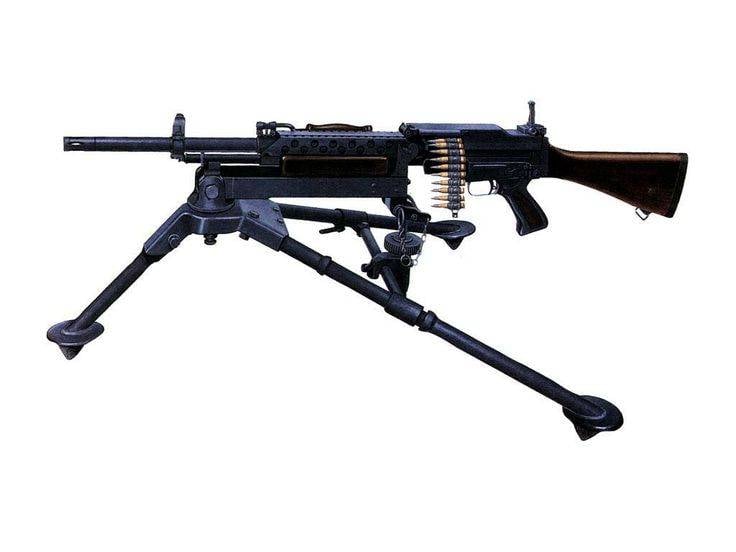
The Stoner 63 A was a light machine gun with venting automatics and band power. The shot was made from the open shutter. The military showed interest in this sample and assigned it the designation HM207. During the Vietnam War, it was used under the designation MK23 "seals", and at the beginning of 1970-x and army special forces. Despite this, this weapon was never officially adopted by any of the types of armed forces due to its complexity and lack of reliability.
The Squad Automatic Weapon (SAW) 1970-1980 program
In the 1966 year, the Small Arms Weapon Study (SAWS) research program developed requirements for light weapons for infantry squad fire support. Its weight with ammunition in 200 cartridges should not exceed 10,5 kg. For comparison: the mass of the M60 machine gun with two hundred rounds of ammunition was 17,6 kg.
In 1970, the program was renamed “Small Automatic Weapon” (SAW). The weapon was to be served by one person, and in battle it occupied an intermediate position between individual small arms and МХNUMX machine guns.
In 1972, the US Department of Defense announced a competition for such weapons for general-purpose troops, but the US Army developed its technical requirements only in 1977. Four manufacturers were admitted to the competition.
XM248 LMG (Ford Aerospace USA)
A feature of this sample was simplicity. The number of its parts was on 40% less than that of other machine guns of this class. This meant lower costs in mass production. To improve the accuracy of shooting, balanced automatics were used, and the firing rate when shooting in bursts was reduced to 500 rounds per minute.
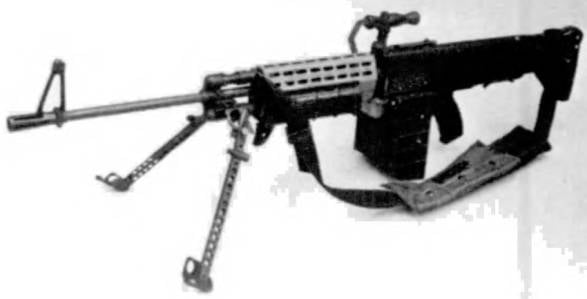
TTX
Caliber: 5,56x45
Patron: HM777 / HM778
Cutting step: 305 mm
Bullet weight:
lead shell - 3,5 g
tracer - 3,4 g
Automation: gas outlet
Food: tape
Weight: 5,3 kg
Rate of Fire: 500 fps. / Min.
Note: shot from the open shutter
XM262 (HK23A-1) Heckler und Koch
The basis for this weapon served as a machine gun HK21 caliber 7,62 x51, designed for the Bundeswehr, but never adopted. The weapon is similar to the automatic G3 rifle. Automatic equipment works due to return of a semi-free shutter with deceleration by rollers.
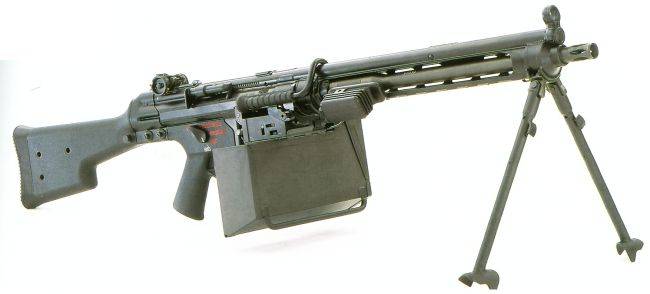
Heckler und Koch has joined the SAW program since the middle of 1970. In accordance with its requirements, the design of the machine gun was redesigned to use the cartridge 5,56 x45, and the weight is significantly reduced. Tests of weapons passed with standard cartridges M193 and M196. But the conditions have changed, and the Canadian HM287 and XM288 high power cartridges already mentioned above should have been used in weapons, and this weapon was not calculated for them. During the tests, frequent breaks of thin-walled shells occurred, which led to the failure of NK23А in the competition.
TTX
Caliber: 5,56x45
Patron: HM777 / HM778
Cutting step: 305 mm
Bullet weight:
lead shell - 3,5 g
tracer - 3,4 g
Automation: due to the return of the semi-free shutter with the slowing rollers
Food: tape
Weight: 7,6 kg
Rate of Fire: 800 fps. / Min.
Note: the shot is made from the closed shutter
XM106 - Heavy Barrel
This development began in 1978 and was funded by the US Army R & D Office for Armed Forces (US Army ARRADCOM). It was conducted by a ballistic research laboratory, the Aberdeen Proving Ground and Colt. The weapon was a modified M16А1 rifle, equipped with a thick-walled barrel with a quick-change mechanism and a bipedal bipod. Power was supplied from a standard magazine on 30 cartridges or from a drum cartridge, on a 83 cartridge.
TTX
Caliber: 5,56x45
Patron: HM777 / HM778
Cutting step: 305 mm
Bullet weight:
lead shell - 3,5 g
tracer - 3,4 g
Automation: gas outlet
Food: drum shop on 83 cartridge or standard shop M-16
Weight: 4,8 kg
Rate of Fire: 750 alt./min.
Note: shot from the open shutter
XM249 (FN MINIMI), Belgium
This light machine gun was introduced to the Belgian army as early as 1974, and was tested. Compared to his rivals in the SAW competition, he had the advantage that, as a result of these tests, the necessary changes were made to the design. For example, the power supply system of the store or tape, quick replacement of the barrel were worked out long before the start of the competition SAW. The cutting pitch has been optimized for S109 machineguns with a dual-core 4 gram bullet.
TTX
Caliber: 5,56x45
Patron: SS109 / L110
Cutting step: 178 mm
Bullet weight:
lead shell - 4,02 g
tracer - 4,00 g
Automation: gas outlet
Food: tape or store M-16
Weight: 6,5 kg
Rate of fire: 700-1000 alt./min.
Note: shot from the open shutter
SAW Tests
Trials planned to start in 1978 year. Each manufacturer had to submit 4 weapon samples in the 18 quarter. Six of them were tested in Aberdeen, nine were sent for military trials to Fort Benning (Georgia), the remaining three were kept as reference.
Comparative tests began in April 1979-th. For ten months, weapons samples were tested in the toughest conditions. They were exposed to sand, dust, dirt, after which they were tested for their performance, accuracy at distances up to 1000 meters, suitability for replacing the barrel in less than 10 seconds, safety, wear and tear of parts and their interchangeability, ergonomics. Total conducted 54 test.
The test results, which were evaluated in May 1980, showed that none of the samples submitted fully met the requirements. The best was recognized as HM249 FN MINIMI, which was recommended for adoption. With this positive conclusion for FN, the SAW competition was completed.
M249 SAW
However, FN had to make a number of changes to the design of the weapon. In 1982, FN presented a modified model HM249EX1, which after successful tests was adopted by the US Army under the designation M249, complete with a new improved cartridge of the caliber 5,56x45.
The first to acquire this weapon was the Marine Corps in the same year. It was followed by the army, ordering 68000 such machine guns. According to this order, the first 2000 samples could be made in Belgium. Since 1984, the production of the M249 was to be established in the city of Colombia (J. Carolina).
New cartridge for M249
In 1982, the United States acquired from FN the right to manufacture FN SS109 cartridges (US designation M855) with a dual core and a FN SS110 tracking cartridge (M856). Production was launched at the Lake City Army Ammunition Plant (LCAAP) cartridge plant.
The spread of FN MINIMI in the world
Simultaneously with the SAW program in the USA in Europe, within the framework of NATO, a competition for a new cartridge was held. And here in the section “Light group weapons of support” the Belgian FN MINIMI with the SS109 cartridge had an advantage and was recommended for use in NATO armies. These successes brought to the Belgian concern numerous orders for MINIMI and its variants from 75 countries of the world, including from many NATO countries. In some countries, this weapon is still manufactured under license. Over the 35 years, it has perfectly manifested itself in numerous conflicts, including in the extreme conditions of the Middle East. In the middle of the 80's MINIMI, NATO was chosen as the only weapon for testing cartridges.
FN MINIMI Para. Landing option
Some armies needed a compact light machine gun to arm paratroopers and crews of combat vehicles. For this purpose, the developers shortened the MINIMI barrel by 125 mm, and the total length of the weapon by 350 mm. To improve the usability of the weapon was equipped with an adjustable butt and front pistol grip. The initial speed of the bullet with a shortened barrel fell by about 60 m / s, but at short distances, this does not matter much.
Adapted to the requirements of the American Army, the FN MINIMI Para was adopted there under the designation M249X4. He also entered service with the special forces of Great Britain under the designation L110A1, and then L110A2.
Light machine gun Hekler & Koch
The Bundeswehr only in 1995 adopted the 5,56x45 cartridge and the G36 assault rifle, which means that until that moment it did not feel the need for a light support weapon for this caliber. According to the Ministry of Defense, the MG3 machine gun of 7,62x51 caliber that was available at that time could perform the entire range of tasks facing the infantry units. As a result of this "supplier of His Majesty's court", Hekler & Koch did not develop light machine guns. Only the success of the FN MINIMI in the world market and the experience of operating the G36, the first N&K weapon with gas-operated automation, prompted N&K developers in the late 1990s to create a light MG34 machine gun for an intermediate cartridge. They carried out the work on their own initiative, but with an eye on the further adoption of the Bundeswehr. The MG34 was a gas-operated, belt-fed machine gun. The shot is fired from a closed bolt. Rate of fire-850 high / min. Since 2001, the Bundeswehr has joined the work. Hekler & Koch carried out their own extensive testing. Thanks to contacts with the American military, N&K was able to conduct them, including at the Yuma Proving Ground in Arizona. A survivability test was carried out in extreme conditions. Within six days, 34 shots were fired from the MG102000 prototype with two interchangeable barrels. There were no comments on the weapon.
The Bundeswehr showed interest, and together with the WTD91 Test Center of the Bundeswehr, the manufacturers of Dynamit Nobel AG and MEN cartridges, the machine gun was modified to use the already adopted DM11 dual-core cartridges and DM21 tracer.
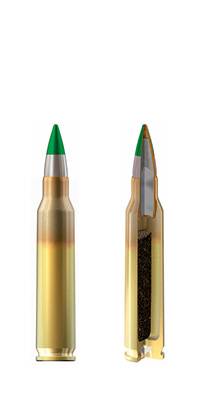
In 2004, the light machine gun was adopted by the Bundeswehr under the designation MG4
New trends in the US
Based on the experience of the war in Iraq, on the initiative of the Marine Corps in 1999, the development of a light “infantry automatic rifle” (IAR) was started. But practical work began only six years later. The new weapon was supposed to have only store supply and also be lighter, more compact and more accurate than the M249.
In 2006, Colt, H&K and FN were invited to participate in the competition and presented technical requirements for the weapon. The winner was H&K with its NK416, but tests continued for two more years, including in real combat operations in Afghanistan.
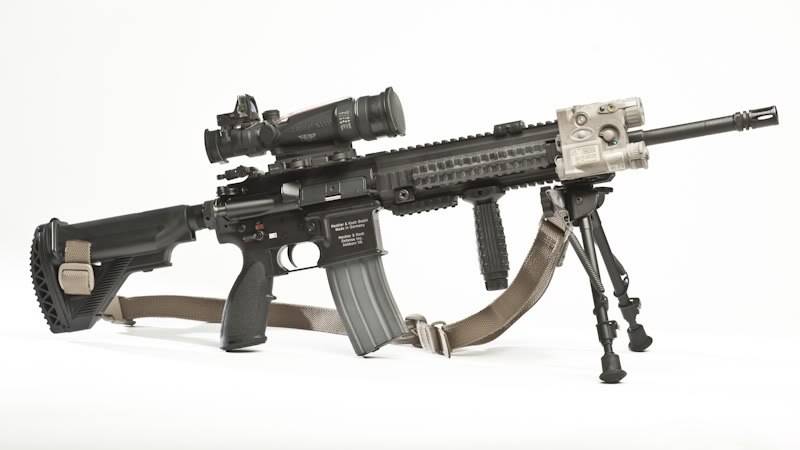
In 2011, H&K received an order for 6500 M27 IAR light machine guns. The number of M249s in the Marine Corps was reduced by the same number. This decision was met with controversy among the troops. Supporters of a full-fledged light machine gun emphasized the impossibility of conducting intensive automatic fire “to suppress” and the inconvenience of loading and replacing 30-seat magazines.
Proponents of the same concept praise the ease, convenience and low impact of new weapons. An important argument is the high accuracy of firing single long-range with good optics.
After tests conducted on the basis of the 2 battalion of the 7 regiment of the marines in a real combat situation, it was concluded that the new weapons are superior to the existing M249.
Prospects
How will the further development of light support weapons go? Most likely, the light machine gun with tape feed will remain as an important component of the infantry weapons. The only question is whether it will remain, as before, the most important weapon of the infantry department, or will it be at least partially replaced by new, automatic rifles adapted for this purpose. Partially this question will be answered by the upcoming replacement of G36 with a new weapon.
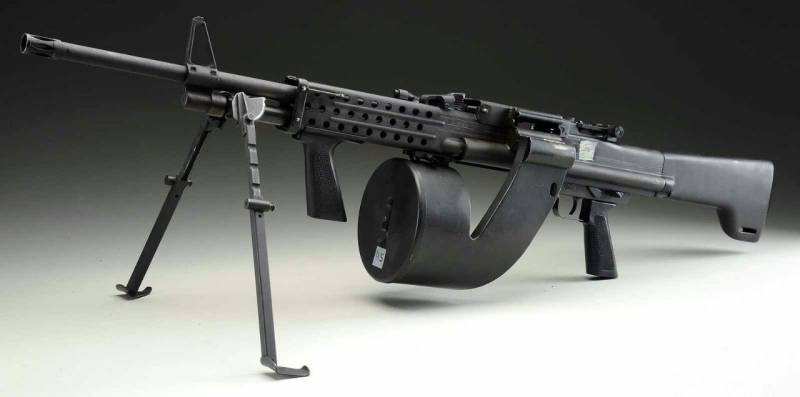
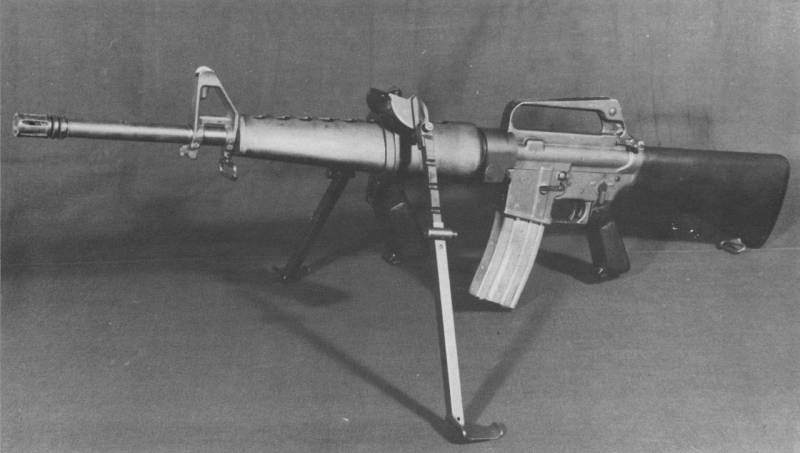
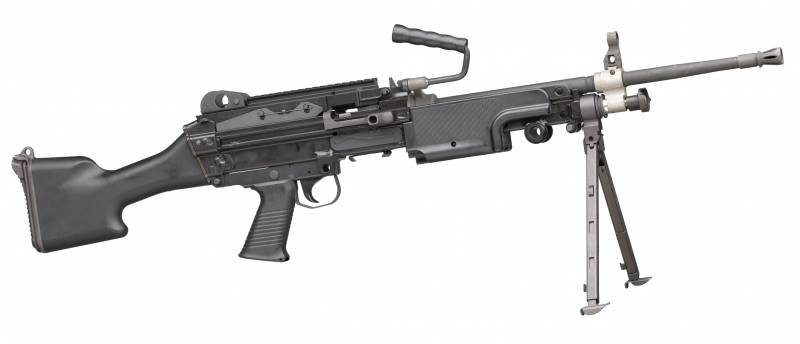
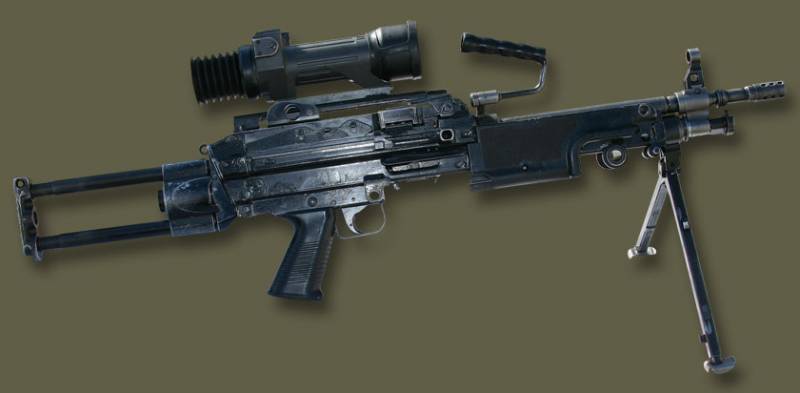
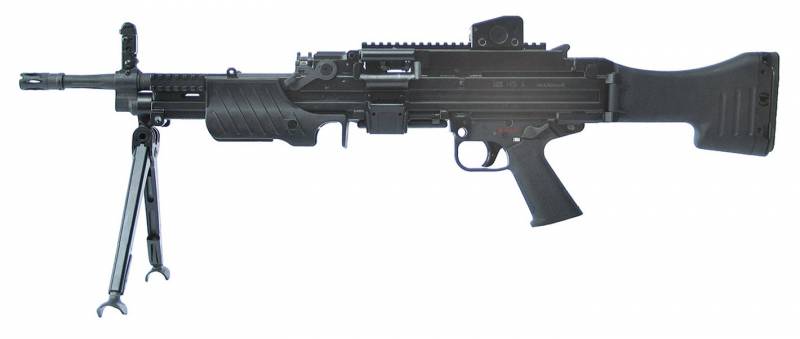
Information